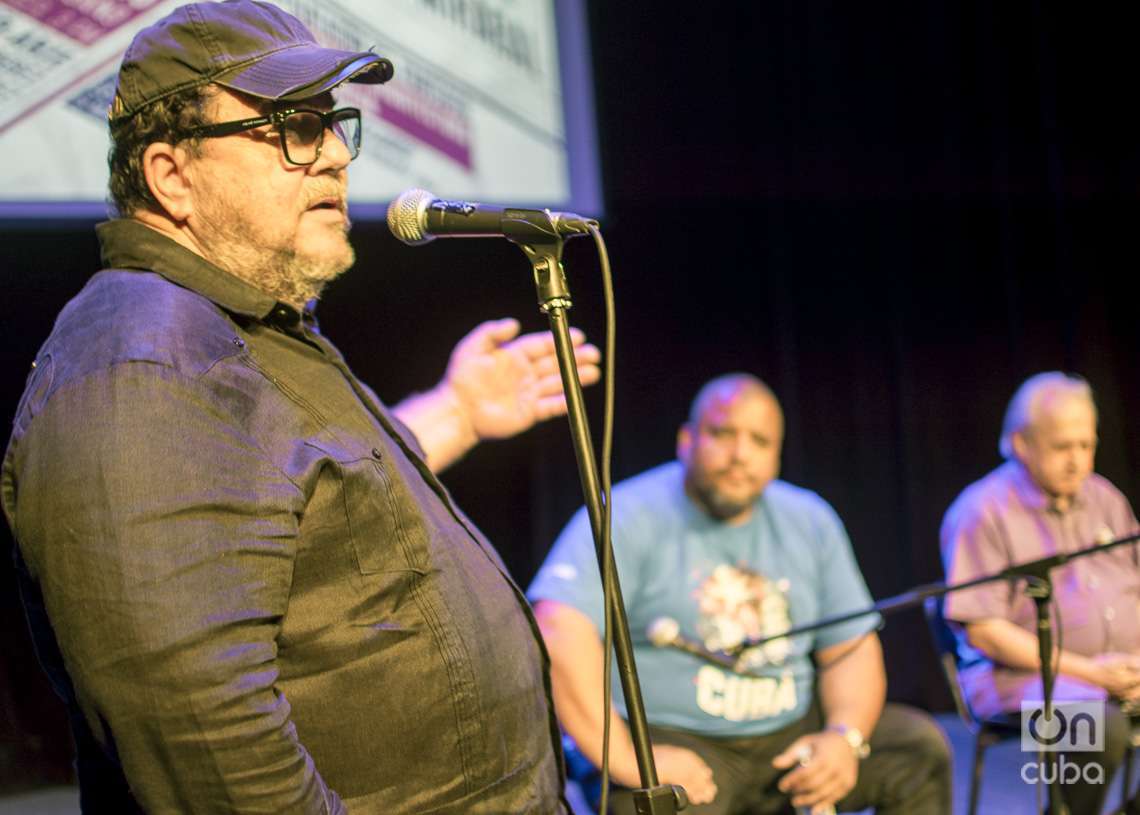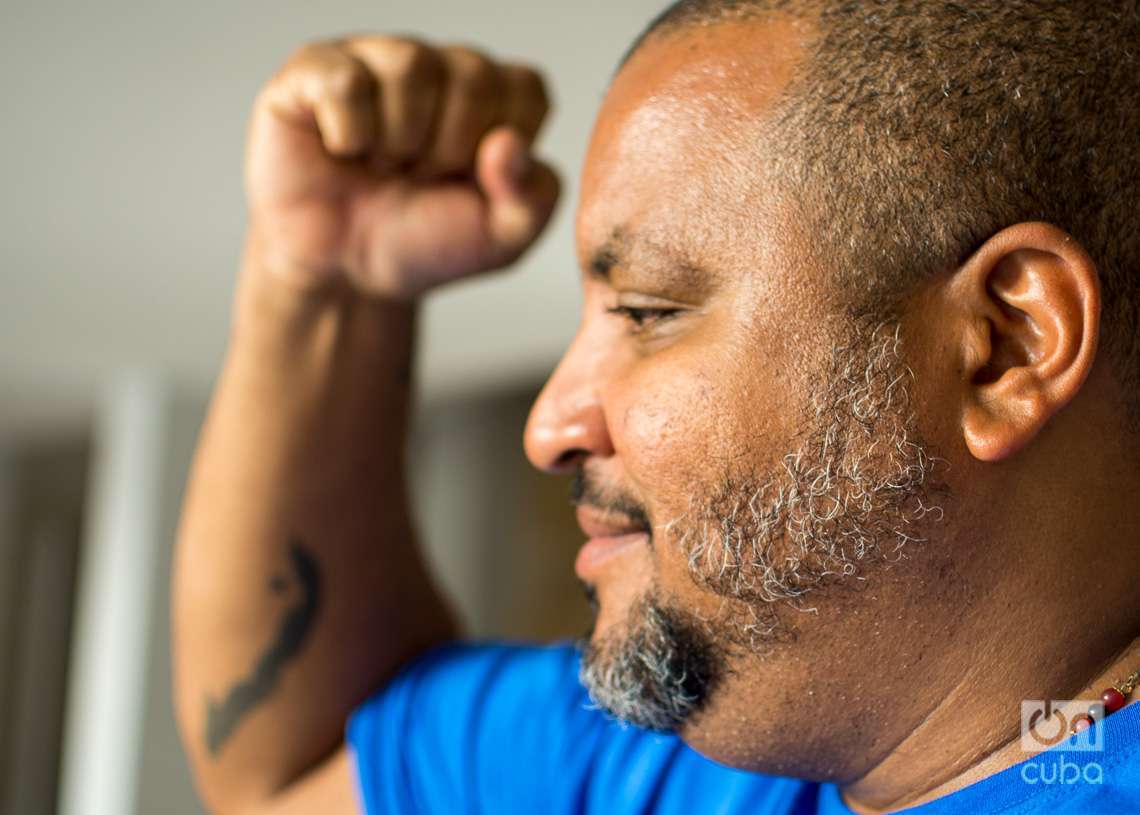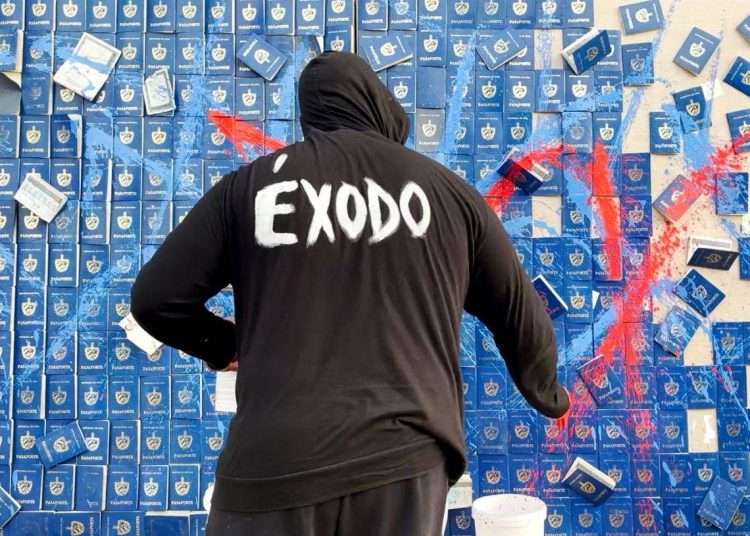Migrants who run, who desperately scale the border walls, who travel on the roof of “La Bestia,” the death train. Migrants who jump into the sea, who sail crowded in fragile boats, who escape when they reach the promised land. Migrants who cry, who suffer, who die before the impassive eyes of the world.
All of this and more is emotionally condensed in “Exodus: Causes and Consequences,” a video art focused on the issue of migration, on the denunciation of its dramas and pain, and which combines the talents of three well-known Cuban creators: artist Michel Mirabal, audiovisual director Alejandro Pérez and maestro Frank Fernández, National Music Award.
The piece, barely five minutes long, had its premiere this Tuesday at the theater of the National Museum of Fine Arts, in Havana, and will be part of the artistic project that Mirabal will exhibit as of May at the Venice Architecture Biennale.
As part of the exhibition, entitled “Architecture of a system,” the video will be shown constantly in front of seats installed in one of the rooms of the Venetian Institute of Sciences, Letters and Arts, in the Loredan Palace, from May 18 to July 23. Several rooms of this historic Venetian building will be occupied by the works of the Cuban artist during the event, curated by the experienced Nelson Herrera Ysla.
Precisely, “Exodus…” also reveals moments of the creative process of another of the pieces that will be exhibited in the famous city of canals. In it, Mirabal has intervened with splashes of paint — red, white and blue, like the colors of the flags of several countries, including Cuba — a group of passports fixed on a canvas, in another direct reference to the immigration theme, the common thread of the project.
There is, logically, no shortage of references to the Cuban migratory scene, beyond passports and allegorical colors. In the archive images used in the video art, passages of the departures through the port of Mariel in 1980 can be appreciated, and also of the crisis of the rafters a decade later. But, as its creators insist, the piece extends its gaze to emigration as a painful contemporary phenomenon that spans the entire planet, from America to Africa, from the Caribbean to the Mediterranean.
And in a visual analogy, the artist — and with him, the spectator — contemplates ants moving around the globe, traveling in a caravan, seen from a higher plane. Ants that represent the anguishing walk of migrants.
From an overhead perspective, migrating humans resemble the path of ants searching for food and shelter. For an indolent observer, looking into the distance, they are nothing more than points in the immensity of the territory; points that move as a group.
It is, in the opinion of the curator, one of the highlights of the exhibition, which summarizes its central axis and gives coherence to a group of installations, paintings and sculptures in a “very complex” setting, to which the exhibition must integrate while preserving its architectural and patrimonial values to the maximum.
“Exodus…,” which closes with a sadly famous and shocking image — of which we will not make spoilers —, will be screened halfway through the artistic tour of the Palace rooms and will integrate symbolic scarecrows as part of its audience, as described by the also art critic.
“A strong message”
“Exodus…” is a work before which it is very difficult to remain indifferent. And in this, the effective combination of music with moving images is fundamental, as Herrera Ysla highlighted in his presentation. It appeals to a montage that does not seek to overwhelm but to move, that exposes only a limited sample of the subject, but that manages to capture all the drama, all the tragedy, and calls, to more than reflection, to act without delay to face the causes and consequences of the phenomenon.
“It is a strong message because the theme is very strong,” said Mirabal, who emphasized that it is a reality that is overwhelming and touches him closely as an artist and as a person, as well as his creative colleagues.
One of them, director Alejandro Pérez, thanked Michel for the opportunity to address this issue, for “its urgency” and its multiple repercussions, and also for being able to work with him and Frank Fernández on the video, which premiered this Tuesday at the Museum of Fine Arts served as a prologue to the vast and ambitious project that will be exhibited at the Venice Architecture Biennale.

Pérez said he was “very happy” with the result and commented to the public that “Exodus…” is intended to be a “strong call for attention” about the migratory phenomenon, “a call to face it and stop its terrible consequences”; an appreciation with which Frank Fernández agreed.
The notable composer and virtuoso pianist called the video a “great protest song” on a “very painful, intense, terrible” subject, and praised the team dynamics that allowed the three creators to carry out “a work as collective as rarely happens.”
Thanks to this integration, as he explained to a question from OnCuba, he was able to start from “key images” suggested by Pérez, and the opinions and guidelines — such as the title itself — given by Mirabal, to compose a piece that could convey the drama of the migrants “in all their intensity.”
A piece of music that “begins with an electroacoustic element and ends with a sound of telluric romanticism, of great loneliness,” like the one that, from his perspective, those who decide to emigrate suffer. To do this, he appealed to a very serious last note, in a tessitura “that not even the contrabassoon has,” as a “protest against the causes of migration and its painful consequences.”
Mirabal: “The result fills us with emotion”
Considered one of the most important plastic artists in Cuba today, Michel Mirabal (1974) does not hide his satisfaction with “Exodus…,” and believes that it is “perfect” to integrate into the artistic group that he will present in Venice, with the curatorship of Herrera Ysla, something unprecedented in his already renowned career.
“The production of this exhibition is very strong. We’re working with people who make movies, who do special effects, and this is going to be something I’ve never done in my life. And I think that video art works perfectly with this idea, because of how it has turned out and the way it connects with the rest of the works,” the artist, who in the next few days will leave for Spain to continue working on the project, told OnCuba.
About his creative relationship with Alejandro Pérez and Frank Fernández, he says that both “have been personal friends for a long time, but, in addition, I am a great admirer of their work, because I consider that they are great artists and it is a privilege that they can accompany me in this project.
“We had already done other works together and it seemed important to invite them again, because I thought they had a lot to contribute to this video art and I was not wrong. I am really very satisfied with the way we worked and, of course, with the result, because I think it conveys very well the idea, the meaning, of what we set out to do.”
Regarding the selection of the subject of the audiovisual, which is integrated into the exhibition in Venice, he acknowledges that “it is not really new.” “Migrations, exodus, have existed for a long time, practically since the origin of humanity. But this is a very strong phenomenon in the contemporary world, and that is what we seek to reflect in the video,” he affirms, “to talk about what is happening in this sense in the time in which we have had to live, about what has been happening in recent years, not only in Cuba, where we know it is a very sensitive issue, but throughout the world, due to wars, displaced persons, the economic crisis, and political differences.
“The video is intended to show that reality and call everyone’s attention, to really concern themselves with this situation, to do everything in our power to alleviate the suffering it generates. That is something that seems fundamental to me, because it is a very human issue, which affects us all in many ways, as humanity, as a country, as a family, and I think we should pay more attention to it instead of more material things, more superficial, which is often imposed by the media and contemporary society,” he reflects.

“Each artist has his own proposal, his own stamp, and that is what I have tried to do with this project as well,” says Mirabal. “I have sought to imprint on the pieces that I am going to exhibit in Venice my way of seeing things, and in the case of video art, to combine my perspective with the ideas and interpretations of Alejandro Pérez and Frank Fernández on the subject that we address in the work.
“I think that the three of us managed to integrate very well,” he considers, “based on the guidelines that we established, in the selection of the images that we planned to use, in the composition of the music, for which Frank, very humbly, asked us for our opinion; but what can be said to a maestro like him. The truth is that it was an intense process, very rich, and I think that what finally remained has left us very happy, very satisfied as artists and fills us with emotion.”














